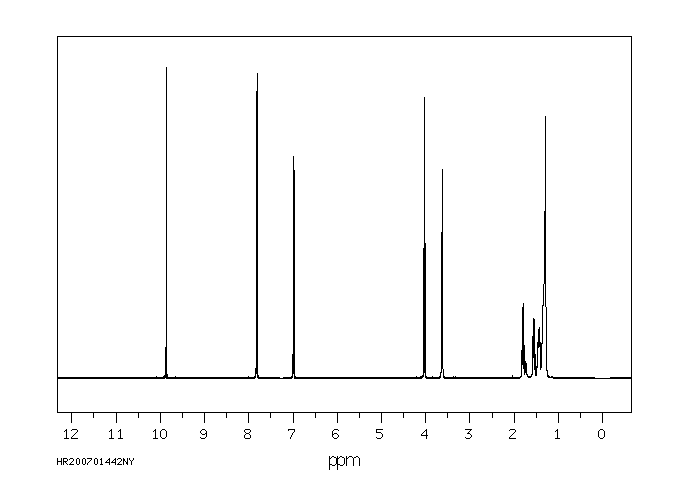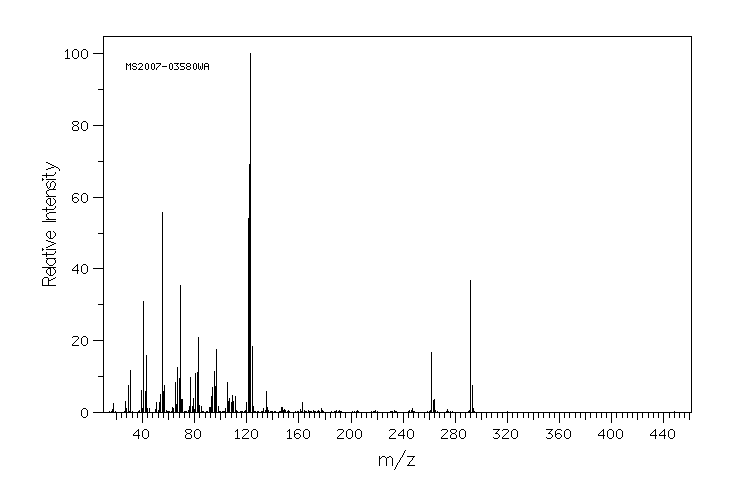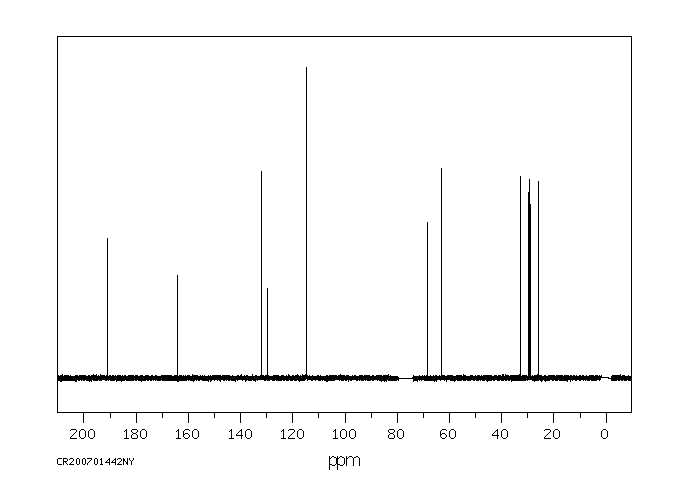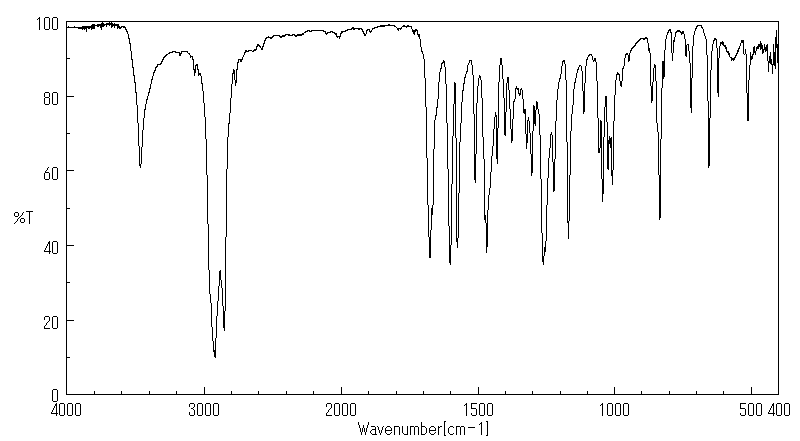4-(11-羟基烷氧基)苯甲醛 | 124389-14-6
中文名称
4-(11-羟基烷氧基)苯甲醛
中文别名
4-(11-羟基十一烷氧基)苯甲醛
英文名称
4-[(11-hydroxyundecyl)oxy]benzaldehyde
英文别名
4-(11-Hydroxyundecyloxy)benzaldehyde;4-(11-hydroxyundecoxy)benzaldehyde
CAS
124389-14-6
化学式
C18H28O3
mdl
——
分子量
292.419
InChiKey
YUNZXZMRQBKWQP-UHFFFAOYSA-N
BEILSTEIN
——
EINECS
——
-
物化性质
-
计算性质
-
ADMET
-
安全信息
-
SDS
-
制备方法与用途
-
上下游信息
-
文献信息
-
表征谱图
-
同类化合物
-
相关功能分类
-
相关结构分类
物化性质
-
熔点:64 °C
-
沸点:439.2±15.0 °C(Predicted)
-
密度:1.016±0.06 g/cm3(Predicted)
-
溶解度:溶于甲醇
计算性质
-
辛醇/水分配系数(LogP):4.9
-
重原子数:21
-
可旋转键数:13
-
环数:1.0
-
sp3杂化的碳原子比例:0.61
-
拓扑面积:46.5
-
氢给体数:1
-
氢受体数:3
安全信息
-
海关编码:2912491000
-
储存条件:室温且干燥
SDS
4-(11-Hydroxyundecyloxy)benzaldehyde Revision number: 5
SAFETY DATA SHEET
Section 1. IDENTIFICATION
Product name: 4-(11-Hydroxyundecyloxy)benzaldehyde
Revision number: 5
Section 2. HAZARDS IDENTIFICATION
GHS classification
PHYSICAL HAZARDS Not classified
Not classified
HEALTH HAZARDS
ENVIRONMENTAL HAZARDS Not classified
GHS label elements, including precautionary statements
Pictograms or hazard symbols None
No signal word
Signal word
Hazard statements None
None
Precautionary statements:
Section 3. COMPOSITION/INFORMATION ON INGREDIENTS
Substance/mixture: Substance
Components: 4-(11-Hydroxyundecyloxy)benzaldehyde
Percent: >98.0%(LC)
CAS Number: 124389-14-6
Chemical Formula: C18H28O3
Section 4. FIRST AID MEASURES
Inhalation: Remove victim to fresh air and keep at rest in a position comfortable for breathing.
Get medical advice/attention if you feel unwell.
Skin contact: Remove/Take off immediately all contaminated clothing. Rinse skin with
water/shower. If skin irritation or rash occurs: Get medical advice/attention.
Eye contact: Rinse cautiously with water for several minutes. Remove contact lenses, if present
and easy to do. Continue rinsing. If eye irritation persists: Get medical
advice/attention.
Ingestion: Get medical advice/attention if you feel unwell. Rinse mouth.
A rescuer should wear personal protective equipment, such as rubber gloves and air-
Protection of first-aiders:
tight goggles.
Section 5. FIRE-FIGHTING MEASURES
Suitable extinguishing Dry chemical, foam, water spray, carbon dioxide.
media:
Precautions for firefighters: Fire-extinguishing work is done from the windward and the suitable fire-extinguishing
method according to the surrounding situation is used. Uninvolved persons should
evacuate to a safe place. In case of fire in the surroundings: Remove movable
containers if safe to do so.
4-(11-Hydroxyundecyloxy)benzaldehyde
Section 5. FIRE-FIGHTING MEASURES
Special protective When extinguishing fire, be sure to wear personal protective equipment.
equipment for firefighters:
Section 6. ACCIDENTAL RELEASE MEASURES
Personal precautions, Use personal protective equipment. Keep people away from and upwind of spill/leak.
protective equipment and Entry to non-involved personnel should be controlled around the leakage area by
emergency procedures: roping off, etc.
Environmental precautions: Prevent product from entering drains.
Methods and materials for Sweep dust to collect it into an airtight container, taking care not to disperse it.
containment and cleaning Adhered or collected material should be promptly disposed of, in accordance with
up: appropriate laws and regulations.
Section 7. HANDLING AND STORAGE
Precautions for safe handling
Handling is performed in a well ventilated place. Wear suitable protective equipment.
Technical measures:
Prevent dispersion of dust. Wash hands and face thoroughly after handling.
Use a local exhaust if dust or aerosol will be generated.
Advice on safe handling: Avoid contact with skin, eyes and clothing.
Conditions for safe storage, including any
incompatibilities
Keep container tightly closed. Store in a cool and dark place.
Storage conditions:
Store away from incompatible materials such as oxidizing agents.
Packaging material: Comply with laws.
Section 8. EXPOSURE CONTROLS / PERSONAL PROTECTION
Engineering controls: Install a closed system or local exhaust as possible so that workers should not be
exposed directly. Also install safety shower and eye bath.
Personal protective equipment
Respiratory protection: Dust respirator. Follow local and national regulations.
Hand protection: Protective gloves.
Eye protection: Safety glasses. A face-shield, if the situation requires.
Skin and body protection: Protective clothing. Protective boots, if the situation requires.
Section 9. PHYSICAL AND CHEMICAL PROPERTIES
Physical state (20°C): Solid
Form: Crystal- Powder
Colour: White - Very pale yellow
Odour: No data available
pH: No data available
Melting point/freezing point:64°C
Boiling point/range: No data available
Flash point: No data available
Flammability or explosive
limits:
No data available
Lower:
Upper: No data available
No data available
Relative density:
Solubility(ies):
[Water] No data available
[Other solvents]
Soluble: Methanol
Section 10. STABILITY AND REACTIVITY
Chemical stability: Stable under proper conditions.
Possibility of hazardous No special reactivity has been reported.
reactions:
4-(11-Hydroxyundecyloxy)benzaldehyde
Section 10. STABILITY AND REACTIVITY
Incompatible materials: Oxidizing agents
Hazardous decomposition Carbon monoxide, Carbon dioxide
products:
Section 11. TOXICOLOGICAL INFORMATION
Acute Toxicity: No data available
Skin corrosion/irritation: No data available
Serious eye No data available
damage/irritation:
Germ cell mutagenicity: No data available
Carcinogenicity:
IARC = No data available
NTP = No data available
Reproductive toxicity: No data available
Section 12. ECOLOGICAL INFORMATION
Ecotoxicity:
Fish: No data available
No data available
Crustacea:
Algae: No data available
Persistence / degradability: No data available
Bioaccumulative No data available
potential(BCF):
Mobility in soil
No data available
Log Pow:
Soil adsorption (Koc): No data available
No data available
Henry's Law
constant(PaM3/mol):
Section 13. DISPOSAL CONSIDERATIONS
Recycle to process, if possible. Consult your local regional authorities. You may be able to dissolve or mix material
with a combustible solvent and burn in a chemical incinerator equipped with an afterburner and scrubber system.
Observe all federal, state and local regulations when disposing of the substance.
Section 14. TRANSPORT INFORMATION
Does not correspond to the classification standard of the United Nations
Hazards Class:
UN-No: Not listed
Section 15. REGULATORY INFORMATION
Safe management ordinance of dangerous chemical product (State Council announces on January 26, 2002
and revised on February 16,2011): Safe use and production, the storage of a dangerous chemical, transport,
loading and unloading were prescribed.
4-(11-Hydroxyundecyloxy)benzaldehyde
SECTION 16 - ADDITIONAL INFORMATION
N/A
SAFETY DATA SHEET
Section 1. IDENTIFICATION
Product name: 4-(11-Hydroxyundecyloxy)benzaldehyde
Revision number: 5
Section 2. HAZARDS IDENTIFICATION
GHS classification
PHYSICAL HAZARDS Not classified
Not classified
HEALTH HAZARDS
ENVIRONMENTAL HAZARDS Not classified
GHS label elements, including precautionary statements
Pictograms or hazard symbols None
No signal word
Signal word
Hazard statements None
None
Precautionary statements:
Section 3. COMPOSITION/INFORMATION ON INGREDIENTS
Substance/mixture: Substance
Components: 4-(11-Hydroxyundecyloxy)benzaldehyde
Percent: >98.0%(LC)
CAS Number: 124389-14-6
Chemical Formula: C18H28O3
Section 4. FIRST AID MEASURES
Inhalation: Remove victim to fresh air and keep at rest in a position comfortable for breathing.
Get medical advice/attention if you feel unwell.
Skin contact: Remove/Take off immediately all contaminated clothing. Rinse skin with
water/shower. If skin irritation or rash occurs: Get medical advice/attention.
Eye contact: Rinse cautiously with water for several minutes. Remove contact lenses, if present
and easy to do. Continue rinsing. If eye irritation persists: Get medical
advice/attention.
Ingestion: Get medical advice/attention if you feel unwell. Rinse mouth.
A rescuer should wear personal protective equipment, such as rubber gloves and air-
Protection of first-aiders:
tight goggles.
Section 5. FIRE-FIGHTING MEASURES
Suitable extinguishing Dry chemical, foam, water spray, carbon dioxide.
media:
Precautions for firefighters: Fire-extinguishing work is done from the windward and the suitable fire-extinguishing
method according to the surrounding situation is used. Uninvolved persons should
evacuate to a safe place. In case of fire in the surroundings: Remove movable
containers if safe to do so.
4-(11-Hydroxyundecyloxy)benzaldehyde
Section 5. FIRE-FIGHTING MEASURES
Special protective When extinguishing fire, be sure to wear personal protective equipment.
equipment for firefighters:
Section 6. ACCIDENTAL RELEASE MEASURES
Personal precautions, Use personal protective equipment. Keep people away from and upwind of spill/leak.
protective equipment and Entry to non-involved personnel should be controlled around the leakage area by
emergency procedures: roping off, etc.
Environmental precautions: Prevent product from entering drains.
Methods and materials for Sweep dust to collect it into an airtight container, taking care not to disperse it.
containment and cleaning Adhered or collected material should be promptly disposed of, in accordance with
up: appropriate laws and regulations.
Section 7. HANDLING AND STORAGE
Precautions for safe handling
Handling is performed in a well ventilated place. Wear suitable protective equipment.
Technical measures:
Prevent dispersion of dust. Wash hands and face thoroughly after handling.
Use a local exhaust if dust or aerosol will be generated.
Advice on safe handling: Avoid contact with skin, eyes and clothing.
Conditions for safe storage, including any
incompatibilities
Keep container tightly closed. Store in a cool and dark place.
Storage conditions:
Store away from incompatible materials such as oxidizing agents.
Packaging material: Comply with laws.
Section 8. EXPOSURE CONTROLS / PERSONAL PROTECTION
Engineering controls: Install a closed system or local exhaust as possible so that workers should not be
exposed directly. Also install safety shower and eye bath.
Personal protective equipment
Respiratory protection: Dust respirator. Follow local and national regulations.
Hand protection: Protective gloves.
Eye protection: Safety glasses. A face-shield, if the situation requires.
Skin and body protection: Protective clothing. Protective boots, if the situation requires.
Section 9. PHYSICAL AND CHEMICAL PROPERTIES
Physical state (20°C): Solid
Form: Crystal- Powder
Colour: White - Very pale yellow
Odour: No data available
pH: No data available
Melting point/freezing point:64°C
Boiling point/range: No data available
Flash point: No data available
Flammability or explosive
limits:
No data available
Lower:
Upper: No data available
No data available
Relative density:
Solubility(ies):
[Water] No data available
[Other solvents]
Soluble: Methanol
Section 10. STABILITY AND REACTIVITY
Chemical stability: Stable under proper conditions.
Possibility of hazardous No special reactivity has been reported.
reactions:
4-(11-Hydroxyundecyloxy)benzaldehyde
Section 10. STABILITY AND REACTIVITY
Incompatible materials: Oxidizing agents
Hazardous decomposition Carbon monoxide, Carbon dioxide
products:
Section 11. TOXICOLOGICAL INFORMATION
Acute Toxicity: No data available
Skin corrosion/irritation: No data available
Serious eye No data available
damage/irritation:
Germ cell mutagenicity: No data available
Carcinogenicity:
IARC = No data available
NTP = No data available
Reproductive toxicity: No data available
Section 12. ECOLOGICAL INFORMATION
Ecotoxicity:
Fish: No data available
No data available
Crustacea:
Algae: No data available
Persistence / degradability: No data available
Bioaccumulative No data available
potential(BCF):
Mobility in soil
No data available
Log Pow:
Soil adsorption (Koc): No data available
No data available
Henry's Law
constant(PaM3/mol):
Section 13. DISPOSAL CONSIDERATIONS
Recycle to process, if possible. Consult your local regional authorities. You may be able to dissolve or mix material
with a combustible solvent and burn in a chemical incinerator equipped with an afterburner and scrubber system.
Observe all federal, state and local regulations when disposing of the substance.
Section 14. TRANSPORT INFORMATION
Does not correspond to the classification standard of the United Nations
Hazards Class:
UN-No: Not listed
Section 15. REGULATORY INFORMATION
Safe management ordinance of dangerous chemical product (State Council announces on January 26, 2002
and revised on February 16,2011): Safe use and production, the storage of a dangerous chemical, transport,
loading and unloading were prescribed.
4-(11-Hydroxyundecyloxy)benzaldehyde
SECTION 16 - ADDITIONAL INFORMATION
N/A
上下游信息
-
上游原料
中文名称 英文名称 CAS号 化学式 分子量 对羟基苯甲醛 4-hydroxy-benzaldehyde 123-08-0 C7H6O2 122.123
反应信息
-
作为反应物:描述:参考文献:名称:Styrene-containing mesogens. Part 1: photopolymerisable nematic liquid crystals摘要:一系列基于氰基联苯致液晶基团的含苯乙烯液晶单体的成员,具有热稳定的向列相。这些材料表现出较大的奇偶效应,与苯乙烯和氰基联苯单元之间柔性连接链的长度有关,这一点与先前描述的由两个氰基联苯单元组成的液晶“二聚体”非常相似。研究表明,与其他多种酚氧基团相比,苯乙烯(即4-乙烯基苯氧基)作为氰基联苯介质的末端基团非常优秀。此外,还描述了一种兼容的双功能介质交联剂。通过在有氧条件下采用阳离子引发,成功实现了由这些化合物衍生的低熔点共晶混合物的对齐薄膜的光聚合。DOI:10.1039/b203940k
-
作为产物:描述:参考文献:名称:Model systems for molecular recognition at interfaces: synthesis and characterisation of functionalised disulfides with hydrogen-bonding properties摘要:合成了一系列分别以巴比妥酸和 2,4,5,6- 四氨基嘧啶衍生物为头基团的对称烷烃二硫化物,它们可用于制备金上的功能化单层。DOI:10.1039/cc9960001193
文献信息
-
PHOTOREACTIVE COMPOUNDS申请人:Lincker Frederic公开号:US20140192305A1公开(公告)日:2014-07-10The present invention relates to photoreactive compounds that are particularly useful in materials for the alignment of liquid crystals.本发明涉及光反应性化合物,特别适用于液晶对准材料的制作。
-
Thermal and Electrooptical Properties of Ferroelectric Liquid Crystals Having OH Groups作者:Kazuo Sugiyama、Koichi Kato、Kohei ShiraishiDOI:10.1246/bcsj.64.1652日期:1991.5Four kinds of ferroelectric liquid crystals (FLCs) possessing OH groups, ((S)-2-methylbutyl 4-[4-(11-hydroxyundecyloxy)benzylideneamino]cinnamate 4a, (S)-2-methylbutyl 4-[4-(11-hydroxyundecyloxy)-2-hydroxybenzylideneamino]cinnamate 4b, (S)-2-hydroxypropyl 4-[4-(11-hydroxyundecyloxy)benzylideneamino]cinnamate 4c, and (S)-2-hydroxypropyl 4-[4-(11-hydroxyundecyloxy)-2-hydroxybenzylideneamino]cinnamate 4d) were prepared in order to understand how the introduction of OH groups in FLCs affect the phase behavior and electrooptical effects. α,ω-Diols 4c and 4d show a higher transition temperature of the smectic A (SA) phase than do ω-hydroxyl compounds 4a and 4b. Comparing 4b and 4d both of which have an OH group at the o-position of the benzylidene group with 4a and 4c, the former samples show a higher SA-isotropization (I) transition temperature than do the latter ones. It is suggested from IR spectroscopic results that inter- and intramolecular hydrogen bonding contribute to the stabilization of the SA phase. The order of the helical pitch in the chiral smectic C (Sc*) phase was found to be 4b>4a>4d>4c within 1.8–6.6 μm. From an electrooptical effect due to a deformation of the helical structure in the Sc phase, the rise time of the surface director (τsr) and the rise time of the bulk director (τbr) were measured to be as follows: τsr are 850, 1500, 30, and 70 μs, and τbr are 12, 100, 0.17, and 0.35 ms for 4a, 4b, 4c, and 4d, respectively. It was found that the intramolecular hydrogen bonding results in a slower optical response time, whereas intermolecular hydrogen bonding results in a faster one.四种具有氢氧基(OH)团的铁电液晶(FLC)被制备,以了解在FLC中引入OH基团如何影响相行为和电光效应。这些液晶分别为((S)-2-甲基丁基 4-[4-(11-羟基十一烷氧基)苯亚胺基]肉桂酸酯 4a、(S)-2-甲基丁基 4-[4-(11-羟基十一烷氧基)-2-羟基苯亚胺基]肉桂酸酯 4b、(S)-2-羟基丙基 4-[4-(11-羟基十一烷氧基)苯亚胺基]肉桂酸酯 4c 和 (S)-2-羟基丙基 4-[4-(11-羟基十一烷氧基)-2-羟基苯亚胺基]肉桂酸酯 4d。α,ω-二醇 4c 和 4d 的层状相(SA)相转变温度高于ω-羟基化合物 4a 和 4b。比较4b和4d这两种在苯亚胺基o位具有OH基团的样品与4a和4c,前者在SA-各向同性(I)转变温度上高于后者。红外光谱结果表明,分子内和分子间氢键对SA相的稳定有贡献。发现螺旋层状相(Sc*)中的螺距顺序为4b>4a>4d>4c,范围在1.8–6.6微米。由于Sc相中螺旋结构的形变引起的电光效应,测得表面导向器(τsr)和体导向器(τbr)的上升时间分别为:4a、4b、4c 和 4d 的 τsr 分别为850、1500、30、70微秒,τbr 分别为12、100、0.17、0.35毫秒。研究发现,分子内氢键导致光学响应时间变慢,而分子间氢键则导致光学响应时间变快。
-
An ammonium/bis-ammonium switchable molecular shuttle作者:David A. Leigh、Andrew R. ThomsonDOI:10.1016/j.tet.2008.05.130日期:2008.9A pH shuttle has been developed in which the mean position of the macrocycle can be switched between dialkylammonium stations of differing acidities. With only the most basic binding site protonated (dibenzylammonium), the macrocycle resides almost exclusively on the protonated station; when the second ammonium group (diethylammonium) is generated by further protonation, a mixture of translational
-
Photoreactive compounds申请人:Lincker Frederic公开号:US09366906B2公开(公告)日:2016-06-14The present invention relates to photoreactive compounds that are particularly useful in materials for the alignment of liquid crystals.本发明涉及光敏化合物,特别适用于液晶材料的取向。
-
[EN] CYANOSTILBENES<br/>[FR] CYANOSTILBÈNES申请人:ROLIC AG公开号:WO2014191292A1公开(公告)日:2014-12-04The present invention relates to novel compounds that are particularly useful for the alignment, especially photoalignment, of slave material, especially liquid crystals for optical or electro-optical applications, such as security applications, liquid crystal devices or optical or electro-optical films.本发明涉及一种新型化合物,特别适用于用于光学或电光应用的从材料,尤其是液晶的定向,特别是光定向,如安全应用、液晶器件或光学或电光薄膜。
表征谱图
-
氢谱1HNMR
-
质谱MS
-
碳谱13CNMR
-
红外IR
-
拉曼Raman
-
峰位数据
-
峰位匹配
-
表征信息
同类化合物
(±)17,18-二HETE
(±)-辛酰肉碱氯化物
(Z)-5-辛烯甲酯
(Z)-4-辛烯酸
(R)-甲羟戊酸锂盐
(R)-普鲁前列素,游离酸
(R,R)-半乳糖苷
(E)-4-庚烯酸
(E)-4-壬烯酸
(E)-4-十一烯酸
(9Z,12E)-十八烷二烯酸甲酯
(6E)-8-甲基--6-壬烯酸甲基酯-d3
(3R,6S)-rel-8-[2-(3-呋喃基)-1,3-二氧戊环-2-基]-3-羟基-2,6-二甲基-4-辛酮
龙胆二糖
黑曲霉二糖
黄质霉素
麦芽酮糖一水合物
麦芽糖醇
麦芽糖酸
麦芽糖基蔗糖
麦芽糖一水合物
麦芽糖
鳄梨油酸乙酯
鲸蜡醇蓖麻油酸酯
鲸蜡醇油酸酯
鲸蜡硬脂醇硬脂酸酯
鲸蜡烯酸脂
鲸蜡基花生醇
鲫鱼酸
鲁比前列素
鲁比前列素
高级烷基C16-18-醇
高甲羟戊酸
高效氯氰菊酯
高-gamma-亚油酸
马来酸烯丙酯
马来酸氢异丙酯
马来酸氢异丁酯
马来酸氢丙酯
马来酸氢1-[2-(2-羟基乙氧基)乙基]酯
马来酸单乙酯
马来酸单丁酯
马来酸二辛酯
马来酸二癸酯
马来酸二甲酯
马来酸二烯丙酯
马来酸二正丙酯
马来酸二戊基酯
马来酸二异壬酯
马来酸二异丙酯










